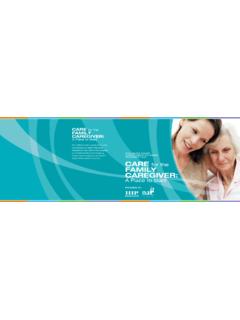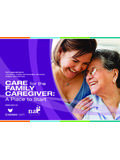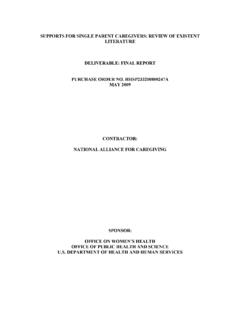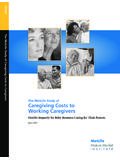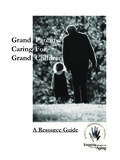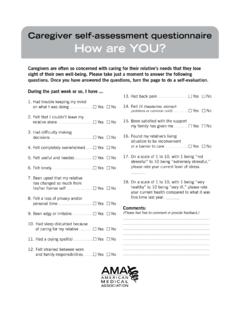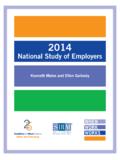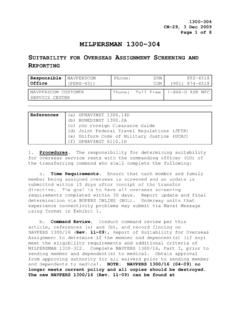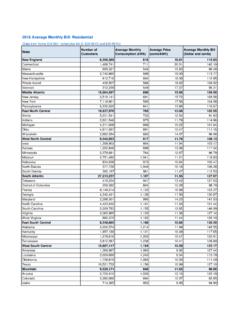Transcription of Caregiving in the U.S. 2009 - National Alliance for Caregiving
1 Caregiving in the 2009. Caregiving in the 2009. National Alliance for Caregiving in collaboration with AARP. November 2009. Funded by MetLife Foundation Acknowledgements The National Alliance for Caregiving , in collaboration with AARP and funded by the MetLife Foundation, is proud to present Caregiving in the , 2009. Many people played important roles throughout the research process including: Gail Gibson Hunt, National Alliance for Caregiving Linda Barrett, , AARP, Knowledge Management Susan Lutz, AARP, Office of Social Impact NAC Advisory Panel Susie Butler, Centers for Medicare & Medicaid Services (CMS). Lynn Friss Feinberg, National Partnership for Women and Families Marty Ford, the Arc Rick Greene, Department of Veterans Affairs Robert Hodapp, , Vanderbilt University Carol Levine, United Hospital Fund of New York City Katie Maslow, Alzheimer's Association Martha Pelaez, International Consultant on Aging and Health Ruth Stein, MD, Albert Einstein College of Medicine Nancy Vuckovic, Intel Donna Wagner, , Towson University The research was conducted for the National Alliance for Caregiving and AARP by Mathew Greenwald & Associates, with study direction by Linda Naiditch and Lisa Weber- Raley.
2 (c) 2009 NAC and AARP. Reprinting with permission i Caregiving in the 2009. Table of Contents I. Introduction .. 1. II. Overview of Methodology .. 2. III. Key Findings .. 4. IV. Detailed Findings .. 12. A. Prevalence of 12. B. Basics of the Caregiving Situation .. 13. C. Caregiving Activities and Burden of Care .. 21. D. Presence of Other Caregivers .. 30. E. Care Recipient Living Situation .. 35. F. Care Recipient's Condition .. 39. G. Strain and Stress of Caregiving .. 47. H. Impact of Caregiving on Work .. 52. I. Information Sources and Needs .. 56. J. Support for 62. K. Respondent Profile .. 67. ii Caregiving in the 2009. Table of Figures Figure 1: Estimates of Household Caregiving Prevalence by Age of 12. Figure 2: Estimates of Household Caregiving Prevalence by Household Race/Ethnicity . 12. Figure 3: Estimates of Individual Caregiving Prevalence by Age of 12. Figure 4: Estimates of Individual Caregiving Prevalence by Age of Predominant Recipient.
3 13. Figure 5: Current vs. Past Care .. 13. Figure 6: Number of Care Recipients .. 14. Figure 7: Gender of Care Recipient and Caregiver .. 14. Figure 8: Age of Predominant Care Recipient .. 15. Figure 9: Age of Predominant Care Recipient by Age of Caregiver .. 16. Figure 10: Age of Caregiver .. 17. Figure 11: Age of Caregiver by Caregiver Race/Ethnicity .. 17. Figure 12: Care Recipient Relation to Caregiver .. 18. Figure 13: Marital Status of Care Recipient .. 19. Figure 14: Duration of Care for Recipient .. 20. Figure 15: Choice in Taking on Caregiver Role .. 20. Figure 16: Hours of Care Provided .. 21. Figure 17: Help with Activities of Daily Living (ADLs) .. 22. Figure 18: Help with Instrumental Activities of Daily Living (IADLs) . for Adult 24. Figure 19: Help with Other Supportive Activities for Adult Recipients .. 26. Figure 20: Help with Caregiving Support Activities (CSAs) for Child Recipients .. 27. Figure 21: Level of Care Index.
4 28. Figure 22: Components of Level of Care by Burden Category .. 28. Figure 23: Burden Category by Caregiver 29. Figure 24: Presence of Other Unpaid 30. Figure 25: Primary Caregiver Status .. 31. Figure 26: Use of Paid Services .. 32. Figure 27: Predominant Caregiver Among Unpaid and Paid Helpers .. 33. Figure 28: Where Care Recipient Lives .. 35. Figure 29: Who Care Recipient Lives With .. 36. Figure 30: Caregiver Distance from Care Recipient .. 37. Figure 31: Frequency of Visits .. 38. Figure 32: Types of Care Recipient Conditions .. 39. Figure 33: Types of Care Recipient Conditions by Age of Recipient .. 40. Figure 34: Main Problem or Illness Identified by Caregiver .. 41. Figure 35: Main Problem or Illness by Age of Recipient .. 42. iii Caregiving in the 2009. Figure 36: Main Problem or Illness by Burden Category .. 42. Figure 37: Presence of Alzheimer's or Mental Confusion .. 43. Figure 38: Limitations of Child Recipients.
5 44. Figure 39: Use of Prescription Medicine .. 44. Figure 40: Medication Management .. 45. Figure 41: Ease of Coordinating Care .. 46. Figure 42: Caregiver Health .. 47. Figure 43: Impact of Caregiving on Caregiver's Health .. 48. Figure 44: Physical Strain of Caregiving .. 49. Figure 45: Emotional Stress of Caregiving .. 50. Figure 46: Time for family and Friends .. 51. Figure 47: Financial Hardship of 51. Figure 48: Concurrence of Employment and Caregiving .. 52. Figure 49: Current Employment Status of Caregiver .. 53. Figure 50: Work Accommodations Due to Caregiving .. 54. Figure 51: Sources Used for Caregiving Information .. 56. Figure 52: Internet Usage for Caregiving Information .. 57. Figure 53: Caregiving Information Sought 58. Figure 54: Caregiving Training .. 59. Figure 55: Caregiving Information Needs .. 60. Figure 56: Use of Services .. 62. Figure 57: Home Modifications .. 63. Figure 58: Use of Technology in 64.
6 Figure 59: Reaction to Caregiving -Related Policies .. 65. Figure 60: Profile of Respondents .. 67. Figure 61: Profile of Respondents Trend in Caregivers of Recipient Age 18+ .. 69. Figure 62: Profile of Respondents by Care Recipient Age .. 72. iv Caregiving in the 2009. Introduction The purpose of this study is to present a portrait of family caregivers today, and to compare it to a portrait of caregivers in the past. A National profile of caregivers first emerged from the 1997 Caregiving in the study. A related study was conducted in 2004, and now, in 2009, we are presenting the results of the third wave of this important study. Each of the three studies has inquired about certain core elements of Caregiving situations, while also exploring new areas. The core areas that we examined include: The prevalence of caregivers in the Demographic characteristics of caregivers and care recipients The Caregiving situation in terms of the nature of Caregiving activities, the intensity and duration of care, the health conditions and living situation of the person to whom care is provided, and other unpaid and paid help provided How caregivers are affected by their role, at work, at home, and in their health situation Information needs and information sources This year's unique areas of exploration were: Use of the Internet for information What public policies would support caregivers Use of technology For the first time, this year's study also includes caregivers of children with special needs, in addition to the caregivers of adults age 50 or older included in the 1997 study and age 18 or older in 2004.
7 The Caregiving of children was distinguished from typical parenting by ensuring that it resulted from a medical, behavioral, or other condition or disability. Because caregivers' situations can vary markedly depending on the age of their care recipient, this report includes three companion reports that separately explore the experiences of caregivers whose loved one is (1) under the age of 18, (2) age 18 to 49, or (3) age 50 or older. In addition, this is the first Caregiving in the report to present data trends. 1. Caregiving in the 2009. Overview of Methodology This report is based primarily on quantitative telephone interviews with 1,480 family caregivers age 18 or older. Caregivers are defined as those who provide unpaid care to an adult or to a child with special needs, as described in the following two questions. In the last 12 months, has anyone in your household provided unpaid care to a relative or friend 18.
8 Years or older to help them take care of themselves? Unpaid care may include help with personal needs or household chores. It might be managing a person's finances, arranging for outside services, or visiting regularly to see how they are doing. This person need not live with you. In the last 12 months, has anyone in your household given unpaid care to any child under the age of 18 because of a medical, behavioral, or other condition or disability? This could include care for ongoing medical conditions or serious short-term ones, emotional or behavioral problems, or developmental problems, including mental retardation. The interviews include a random sample of 1,000 family caregivers and, to supplement the ethnic minority interviews achieved in that sample, 480 additional interviews with minorities. The interviews break out by race as follows: 858 White, non-Hispanic caregivers, 200 African-American caregivers, 201 Hispanic caregivers, 200 Asian- American caregivers, and 21 caregivers of another race.
9 These results came from screening 6,806 adults. In addition to the 1,480 completed caregiver interviews, there were 83 additional validated caregivers who did not complete the interview. The remaining 5,243 screened interviews include 4,795 with no caregiver present and 448 with a non- validated caregiver. The random sample interviews were reached using random digit dialing. Geographic density samples were used to target the oversample of African-Americans. For Hispanics and Asian-Americans, a combination of surname and density sampling was used. In addition, Knowledge Networks screened their Asian panel members to pre-identify Asian- American caregivers. All of the data gathered while screening potential respondents for caregivers were saved in order to estimate the proportion of households that include one or more caregivers. The screening data and survey results are weighted by household, based on the race/ethnicity and age of the householder, and type of household ( family or non- family ) reported by the initial respondent in each household.
10 Weighting targets were derived from the Current Population Survey, 2008 Annual Social and Economic Supplement, conducted by the Census Bureau. In addition to the 1,480 caregiver interviews in the base study, an additional 288 interviews were conducted with caregivers of individuals age 50 or older, bringing the total among this Caregiving subset to 1,397 caregivers, including just over 800 Whites, 200 African- Americans, and 200 Hispanics, as well as 170 Asian-Americans and a small number of other minorities from the base study. The Whites and some of the minorities were reached through random digit dialing. The remaining minorities were reached through targeted samples like those described above. These interviews were weighted according to the 2. Caregiving in the 2009. weighted distribution of caregivers of individuals age 50+ in the base sample by race/ethnicity, age of householder, and type of household ( family or non- family ).

